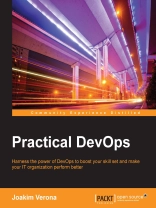Harness the power of Dev Ops to boost your skill set and make your IT organization perform better
About This Book- Get to know the background of Dev Ops so you understand the collaboration between different aspects of an IT organization and a software developer
- Improve your organization’s performance to ensure smooth production of software and services
- Deploy top-quality software and ensure software maintenance and release management with this practical guide
Who This Book Is For
This book is aimed at developers and system administrators who wish to take on larger responsibilities and understand how the infrastructure that builds today’s enterprises works. This book is also great for operations personnel who would like to better support developers. You do not need to have any previous knowledge of Dev Ops.
What You Will Learn- Appreciate the merits of Dev Ops and continuous delivery and see how Dev Ops supports the agile process
- Understand how all the systems fit together to form a larger whole
- Set up and familiarize yourself with all the tools you need to be efficient with Dev Ops
- Design an application that is suitable for continuous deployment systems with Devops in mind
- Store and manage your code effectively using different options such as Git, Gerrit, and Gitlab
- Configure a job to build a sample CRUD application
- Test the code using automated regression testing with Jenkins Selenium
- Deploy your code using tools such as Puppet, Ansible, Palletops, Chef, and Vagrant
- Monitor the health of your code with Nagios, Munin, and Graphite
- Explore the workings of Trac—a tool used for issue tracking
In Detail
Dev Ops is a practical field that focuses on delivering business value as efficiently as possible. Dev Ops encompasses all the flows from code through testing environments to production environments. It stresses the cooperation between different roles, and how they can work together more closely, as the roots of the word imply—Development and Operations.
After a quick refresher to Dev Ops and continuous delivery, we quickly move on to looking at how Dev Ops affects architecture. You’ll create a sample enterprise Java application that you’ll continue to work with through the remaining chapters. Following this, we explore various code storage and build server options. You will then learn how to perform code testing with a few tools and deploy your test successfully. Next, you will learn how to monitor code for any anomalies and make sure it’s running properly. Finally, you will discover how to handle logs and keep track of the issues that affect processes
Style and approachThis book is primarily a technical guide to Dev Ops with practical examples suitable for people who like to learn by implementing concrete working code. It starts out with background information and gradually delves deeper into technical subjects.












